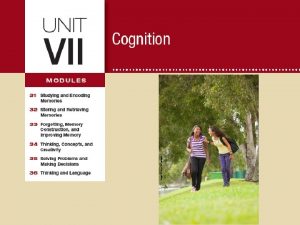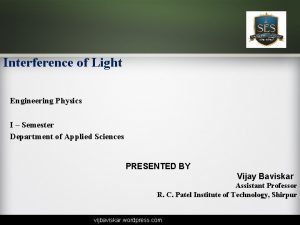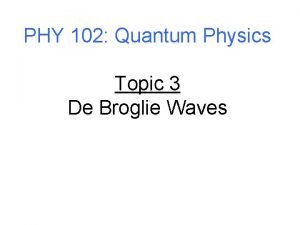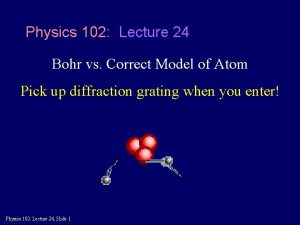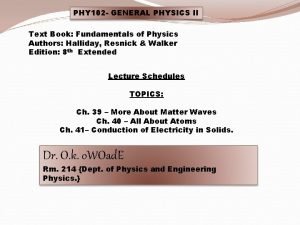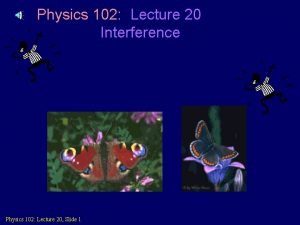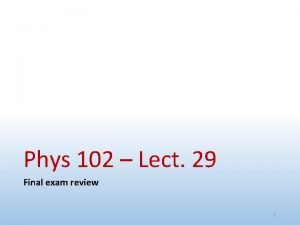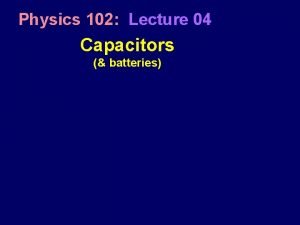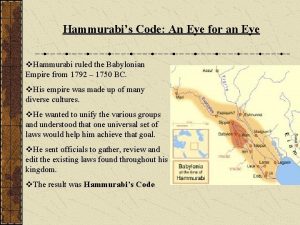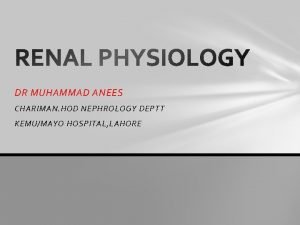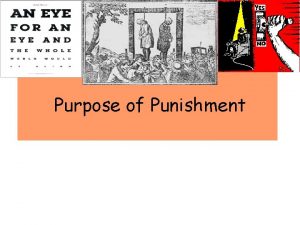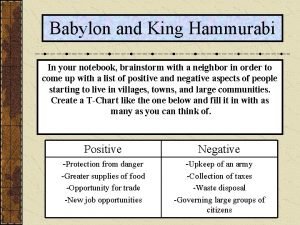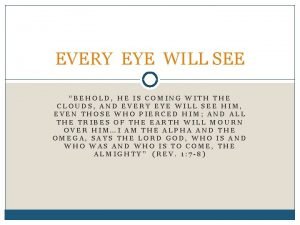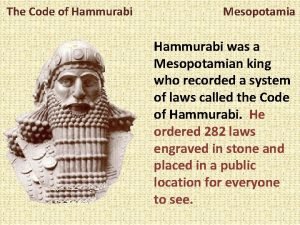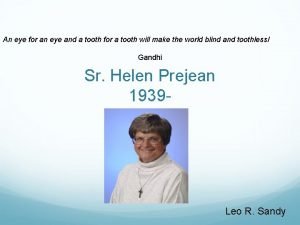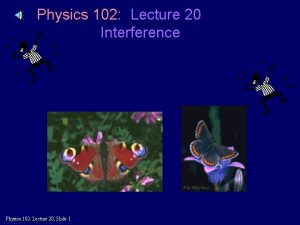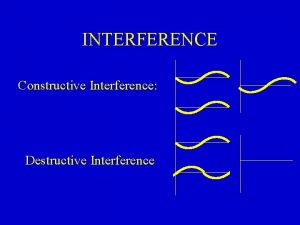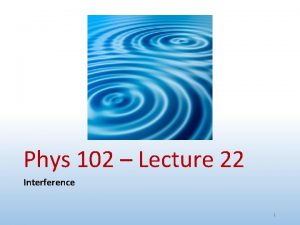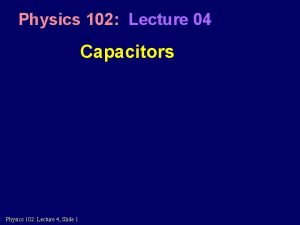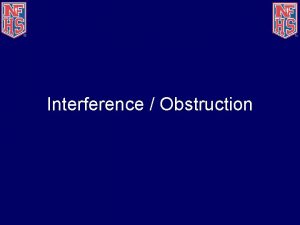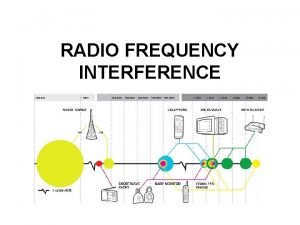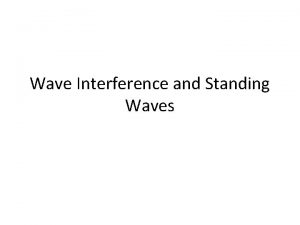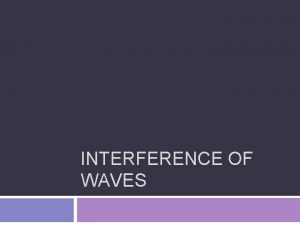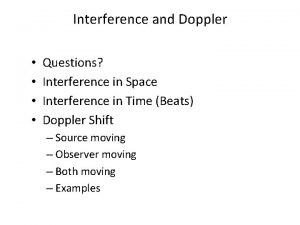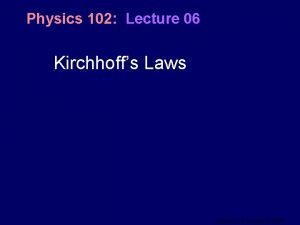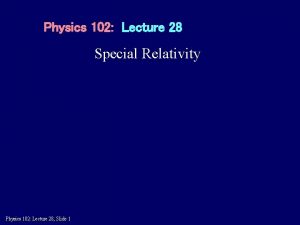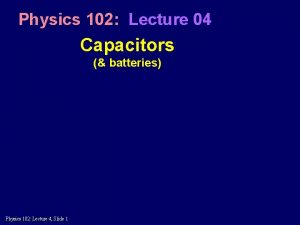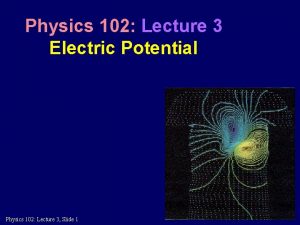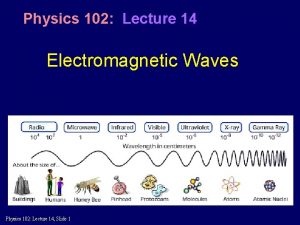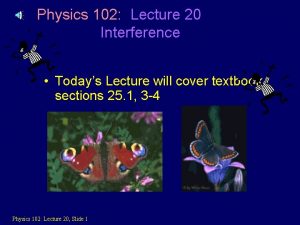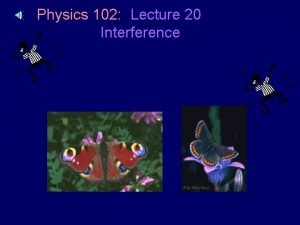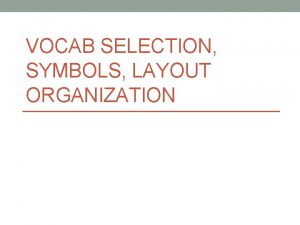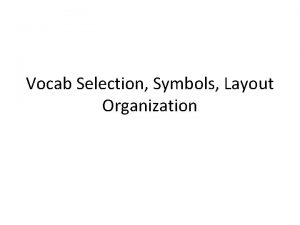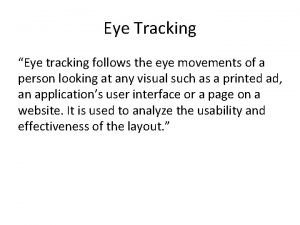Physics 102 Lecture 20 Interference Unaided Eye How




























- Slides: 28

Physics 102: Lecture 20 Interference

Unaided Eye How big the object looks with unaided eye. object h 0 q dnear Bring object as close as possible (to near point dnear) **If q is small and expressed in radians. 47

Angular Size Preflight 19. 6, 19. 7 Both are same size, but nearer one looks bigger. q q • Angular size tells you how large the image is on your retina, and how big it appears to be. • How small of font can you read? Highwire Caramel Apples Rabbits Kindergarten Hello Arboretum Halloween Amazing 46

Magnifying Glass magnifying glass virtual image object hi ho do di Magnifying glass produces virtual image behind object, allowing you to bring object to a closer do: and larger q′ Compare to unaided eye: : Ratio of the two angles is the angular magnification M: 48

Angular Magnification magnifying glass virtual image hi ho di object (dnear = near point distance from eye. ) do 1 1 1 + = Þ = For the lens : do di f do f di For max. magnification, put image at dnear: so set di = -dnear: M = dnear /d 0 = dnear/f +1 Smaller f means larger magnification See text, Example 24. 6 50

Phys 102 recent lectures Light as a wave • Lecture 14 – EM waves • Lecture 15 – Polarization • Lecture 20 & 21 – Interference & diffraction Light as a ray • • Lecture 16 – Reflection Lecture 17 – Spherical mirrors & refraction Lecture 18 – Refraction & lenses (today!) Lecture 19 – Lenses & your eye

Superposition Constructive Interference +1 -1 t + +1 -1 In Phase t +2 t -2 5

Superposition Destructive Interference +1 -1 t + +1 -1 Out of Phase t 180 degrees +2 t -2 7

Superposition ACT + Different f 1) Constructive 2) Destructive 3) Neither 10

Interference Requirements • Need two (or more) waves • Must have same frequency • Must be coherent (i. e. waves must have definite phase relation) 12

Interference for Sound … For example, a pair of speakers, driven in phase, producing a tone of a single f and : hmmm… I’m just far enough away that l 2 l 1= /2, and I hear no sound at all! l 1 l 2 But this won’t work for light--can’t get coherent sources 15

Interference for Light … • Can’t produce coherent light from separate sources. (f 1014 Hz) • Need two waves from single source taking two different paths – Two slits – Reflection (thin films) – Diffraction* Single source Two different paths Interference possible here 18

ACT: Young’s Double Slit Light waves from a single source travel through 2 slits before meeting on a screen. The interference will be: A. Constructive B. Destructive C. Depends on L d Single source of monochromatic light L 2 slitsseparated by d The rays start in phase, and travel the same distance, so they will arrive in phase. Screen a distance L from slits 23

Preflight 20. 1 The experiment is modified so that one of the waves has its phase shifted by ½ l. Now, the interference will be: 1) Constructive ½ l shift 2) Destructive 3) Depends on L d Single source of monochromatic light L 2 slitsseparated by d The rays start out of phase, and travel the same distance, so they will arrive out of phase. Screen a distance L from slits 25

Young’s Double Slit Concept At points where the difference in path length is 0, , 2 , …, the screen is bright. (constructive) d Single source of monochromatic light At points where the difference in path length is L 2 slitsseparated by d the screen is dark. (destructive) Screen a distance L from slits 27

Young’s Double Slit Key Idea L Two rays travel almost exactly the same distance. (screen must be very far away: L >> d) Bottom ray travels a little further. Key for interference is this small extra distance. 30

Young’s Double Slit Quantitative d d Path length difference = d sin q Constructive interference Destructive interference where m = 0, or 1, or 2, . . . Need l < d 32

Young’s Double Slit Quantitative L y d A little geometry… sin(q) tan(q) = y/L Constructive interference Destructive interference where m = 0, or 1, or 2, . . . 33

Preflight 20. 3 L y d When this Young’s double slit experiment is placed under water. The separation y between minima and maxima 1) increases 2) same 3) decreases 21% 23% 53% Under water l decreases so y decreases 35

Preflight 20. 2 In the Young double slit experiment, is it possible to see interference maxima when the distance between slits is smaller than the wavelength of light? 1) Yes Need: d sin q = m l If l>d 2) No => sin q = m l / d then l/d>1 so sin q > 1 Not possible! 35

Thin Film Interference 1 2 t n 0=1. 0 (air) n 1 (thin film) n 2 Get two waves by reflection off two different interfaces. Ray 2 travels approximately 2 t further than ray 1. 37

Reflection + Phase Shifts Incident wave Reflected wave n 1 n 2 Upon reflection from a boundary between two transparent materials, the phase of the reflected light may change. • If n 1 > n 2 - no phase change upon reflection. • If n 1 < n 2 - phase change of 180º upon reflection. (equivalent to the wave shifting by /2. ) 39

Thin Film Summary Determine d, number of extra wavelengths for each ray. 1 2 n 1 (thin film) t This is important! n = 1. 0 (air) n 2 Reflection Distance Ray 1: d 1 = 0 or ½ + 0 Ray 2: d 2 = 0 or ½ + 2 t/ lfilm If |d 2 – d 1| = 0, 1, 2, 3 …. If |d 2 – d 1| = ½ , 1 ½, 2 ½ …. Note: this is wavelength in film! (lfilm= lo/n 1) (m) constructive (m + ½) destructive 42

Thin Film Practice (ACT) 1 2 t n = 1. 0 (air) nglass = 1. 5 nwater= 1. 3 Blue light (lo = 500 nm) incident on a glass (nglass = 1. 5) cover slip (t = 167 nm) floating on top of water (nwater = 1. 3). Is the interference constructive or destructive or neither? What is d 1, the total phase shift for ray 1 A) d 1 = 0 B) d 1 = ½ C) d 1 = 1 45

Thin Film Practice 1 2 t n = 1. 0 (air) nglass = 1. 5 nwater= 1. 3 Blue light (lo = 500 nm) incident on a glass (nglass = 1. 5) cover slip (t = 167 nm) floating on top of water (nwater = 1. 3). Is the interference constructive or destructive or neither? Reflection at air-film interface only d 1 = ½ d 2 = 0 + 2 t / lglass = 2 t nglass/ l 0= (2)(167)(1. 5)/500) =1 Phase shift = d 2 – d 1 = ½ wavelength 45

ACT: Thin Film Blue light l = 500 nm incident on a thin film (t = 167 nm) of glass on top of plastic. The interference is: (A) constructive 1 2 t (B) destructive n=1 (air) nglass =1. 5 nplastic=1. 8 (C) neither d 1 = ½ Reflection at both interfaces! d 2 = ½ + 2 t / lglass = ½ + 2 t nglass/ l 0= ½ + 1 Phase shift = d 2 – d 1 = 1 wavelength 48

Preflights 20. 4, 20. 5 A thin film of gasoline (ngas=1. 20) and a thin film of oil (noil=1. 45) are floating on water t= (nwater=1. 33). When the thickness of the two films is exactly one wavelength… The gas looks: • bright • dark d 1, gas = ½ d 2, gas = ½ + 2 | d 2, gas – d 1, gas | = 2 constructive nair=1. 0 ngas=1. 20 noil=1. 45 nwater=1. 3 The oil looks: • bright • dark d 1, oil = ½ d 2, oil = 2 | d 2, oil – d 1, oil | = 3/2 destructive 50

See you Wednesday!
 Proactive interference
Proactive interference Proactive vs retroactive interference
Proactive vs retroactive interference Interference of light engineering physics
Interference of light engineering physics Electric potential lecture
Electric potential lecture Physics 102
Physics 102 Phys 102 uiuc
Phys 102 uiuc Physics 102
Physics 102 Physics 102
Physics 102 Physics 102
Physics 102 Physics 102 final exam
Physics 102 final exam Physics 102
Physics 102 4 forces of nature
4 forces of nature 01:640:244 lecture notes - lecture 15: plat, idah, farad
01:640:244 lecture notes - lecture 15: plat, idah, farad Hammurabi code eye for an eye
Hammurabi code eye for an eye Worms eye view example
Worms eye view example Blue eyes genetics
Blue eyes genetics Dr anees nephrologist
Dr anees nephrologist An eye for an eye meaning
An eye for an eye meaning Code of hammurabi activity
Code of hammurabi activity Behold he is coming
Behold he is coming Eye for an eye code
Eye for an eye code An eye for an eye a tooth for a tooth sister act
An eye for an eye a tooth for a tooth sister act Waves notes pdf download
Waves notes pdf download Physics 101 lecture notes pdf
Physics 101 lecture notes pdf Atmospheric physics lecture notes
Atmospheric physics lecture notes Physics 101 lecture 1
Physics 101 lecture 1 Physics 101 lecture notes pdf
Physics 101 lecture notes pdf Physics 111 lecture notes
Physics 111 lecture notes Ia examples physics
Ia examples physics

